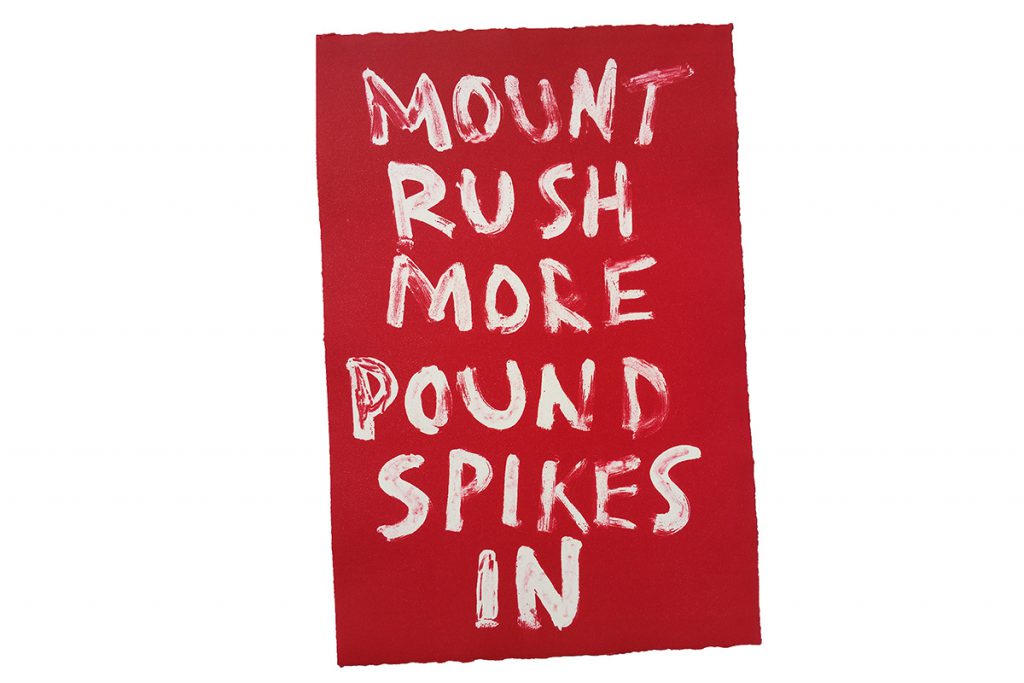
Edgar Heap of Birds: Defend Sacred Mountains
Curated by Bill Anthes and Ciara Ennis
Pitzer College Art Galleries
January 20–March 29, 2018
Opening Reception:
January 20, 3-5 p.m.
Nichols Gallery, Broad Center
Pitzer College
T: 909.607.8797
Pepper Distinguished Visiting Artists and Scholars Lecture
Edgar Heap of Birds
January 23, 4:15 p.m.
Benson Auditorium
Pitzer College
According to noted artist and activist Edgar Heap of Birds, the exhibition Defend Sacred Mountains is a message both ecological and spiritual. Pitzer College Art Galleries is helping him deliver the message.
In Defend Sacred Mountains, a suite of Edgar Heap of Birds’ text prints calls attention and rallies resistance to the desecration of four mountains that are sacred to Native Americans: Bear’s House/Devils Tower, Wyoming; San Francisco Peaks, near Flagstaff, Arizona; Bear Butte, South Dakota; and Mauna Kea, Hawaii. Edgar Heap of Birds documents the history of the sites and the struggle over land rights connected with these four mountains in 64 monoprints that reveal how lands venerated by Native Americans are being plundered. It is this cultural contempt against which Edgar Heap of Birds is crusading.
While the notion of rock-climbing on Mount Rushmore is unthinkable, Edgar Heap of Birds reveals how just such desecration is happening at another hallowed ground: Bear’s House. The name Bear’s House may be unfamiliar; most of us know it by another name: Devils Tower. It is where the aliens landed in Close Encounters of the Third Kind. It is the first National Monument in the US, designated by President Theodore Roosevelt, and draws nearly half a million tourists annually. But Bear’s House is older than the US National Park Service and more important than a tourist attraction. This igneous butte, standing 875 feet tall, is a sacred site to many Native Americans: the Lakota, Arapaho, Cheyenne, Crow, Kiowa, and Shoshone. Yet platoons of climbers drive in spikes as they ascend it.
Nearly 1,000 miles southwest of Bear’s House stand the San Francisco Peaks outside of Flagstaff, Arizona. This area is a harvesting ground for sacred medicine plants used in healing and ceremony for the 300,000 tribal members of the Diné/Navajo nation. Here, waste water is being used to create artificial snow for skiing and snowboarding, causing a melt-off that is deadly and harmful to the numerous Diné medicine plants. Edgar Heap of Birds’ monoprint from this series succinctly skewers the careless pollution: CLEAN YOUR CHURCH WITH SEWER WATER.
The artist evokes the revered nature of Bear Butte in South Dakota in a print that reads THE HILLS WHERE PEOPLE ARE TAUGHT, referring to the site as a sanctuary of fasting and prayer for the Cheyenne people. Thousands of motorcyclists, however, descend upon the sacred site annually for the Sturgis Motorcycle Rally, named for the nearby small town of Sturgis, SD. Nearly half a million visitors a year gather on the sacred ground for corn dogs, country music and wet t-shirt contests. It is this place where Cheyenne people fast and renew vows with a commitment of four days without food or water.
Edgar Heap of Birds also turns our attention across the waters of the Pacific to the dormant volcano Mauna Kea, the largest of five sacred volcanoes on the island of Hawaii, rising nearly 14,000 feet above sea level. Despite the existence of four obsolete telescope structures at Mauna Kea, plans are underway for a new telescope structure on the summit, the most sacred place in the Hawaiian Islands. Protest, blockades and arrests have followed.
Writing in the Smithsonian Magazine about these plans, geographer Doug Herman described the conflict as “between two ways of knowing and being in the world.
“For many Native Hawaiians and other Indigenous peoples, sacredness is not merely a concept or label. It is a lived experience of oneness and connectedness with the natural and spiritual worlds. It is as common sense as believing in gravity. This experience is very much at odds with the everyday secular-humanist approach of Western thinking that emerged out of the Enlightenment and which sees no ‘magic’ or ‘enchantment’ in the world. And of course, seeing nature as inert facilitates both commercial exploitation and scientific exploration.”
Edgar Heap of Birds is more succinct: WE ARE LAND LAND IS US.
The exhibition and programming are generously supported in part by the Office of the Dean of Faculty at Pitzer College, Agnes Moreland Jackson Diversity Program Fund/Campus Life Committee, the Robert Redford Conservancy for Southern California Sustainability, and the Murray Pepper and Vicki Reynolds Pepper Distinguished Visiting Artists and Scholars Endowed Fund.
A survey of the work of Edgar Heap of Birds can also be viewed at Garis & Hahn art gallery in Los Angeles from February 10 to March 10, 2018.
 WORLD IS WATCHING – MANIFESTO
WORLD IS WATCHING – MANIFESTO